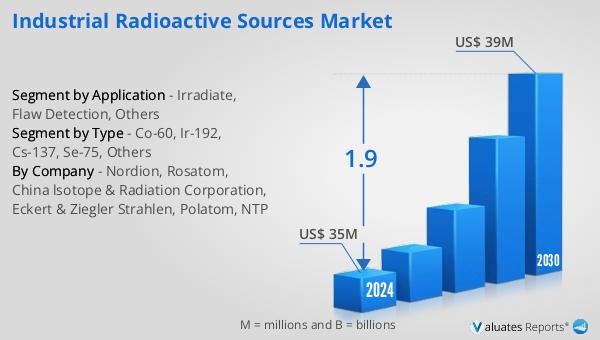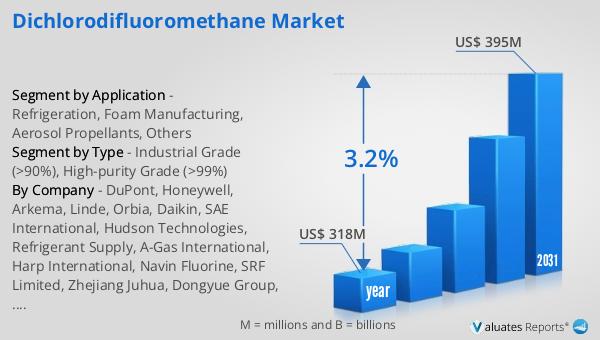What is Global Industrial Radioactive Sources Market?
The Global Industrial Radioactive Sources Market is a specialized sector that deals with the production, distribution, and application of radioactive materials used in various industrial processes. These sources are crucial for a range of applications, including medical, industrial, and research purposes. The market is driven by the demand for non-destructive testing, sterilization, and other industrial applications that require precise and reliable radioactive sources. The market encompasses a variety of isotopes, each with specific properties and uses, such as Cobalt-60 (Co-60), Iridium-192 (Ir-192), Cesium-137 (Cs-137), and Selenium-75 (Se-75). These isotopes are used in industries like oil and gas, manufacturing, and healthcare, where they play a vital role in ensuring safety, quality, and efficiency. The market is characterized by stringent regulations and safety standards to ensure the safe handling and disposal of radioactive materials. As industries continue to evolve and demand more sophisticated technologies, the Global Industrial Radioactive Sources Market is expected to grow, driven by advancements in technology and increasing applications across various sectors. The market's growth is also influenced by regional factors, with significant contributions from regions like Asia-Pacific and Europe.

Co-60, Ir-192, Cs-137, Se-75, Others in the Global Industrial Radioactive Sources Market:
Cobalt-60 (Co-60) is one of the most widely used isotopes in the Global Industrial Radioactive Sources Market. It is primarily used in gamma irradiation processes, which are essential for sterilizing medical equipment, food products, and other materials. Co-60 emits high-energy gamma rays, making it ideal for applications that require deep penetration and uniform dose distribution. This isotope is also used in radiotherapy for cancer treatment, highlighting its versatility and importance in both industrial and medical fields. Iridium-192 (Ir-192) is another critical isotope, predominantly used in non-destructive testing (NDT) and industrial radiography. It is favored for its ability to produce high-resolution images, which are crucial for detecting flaws and ensuring the integrity of structures and components in industries like aerospace, construction, and manufacturing. Cesium-137 (Cs-137) is utilized in a variety of applications, including moisture and density gauges, which are essential for construction and civil engineering projects. Cs-137's long half-life and stable decay make it a reliable choice for continuous monitoring and measurement tasks. Selenium-75 (Se-75) is often used in industrial radiography, particularly for inspecting welds and metal structures. Its lower energy gamma emissions make it suitable for applications where high penetration is not required, providing a safer alternative for certain testing scenarios. Other isotopes in the market include Americium-241 (Am-241) and Californium-252 (Cf-252), each with unique properties that cater to specific industrial needs. Am-241 is commonly used in smoke detectors and gauging devices, while Cf-252 is utilized in neutron radiography and oil exploration. The diversity of isotopes available in the Global Industrial Radioactive Sources Market allows industries to select the most appropriate material for their specific requirements, ensuring optimal performance and safety. The market's growth is supported by ongoing research and development efforts aimed at improving the efficiency and safety of radioactive sources, as well as expanding their applications across various sectors.
Irradiate, Flaw Detection, Others in the Global Industrial Radioactive Sources Market:
The Global Industrial Radioactive Sources Market plays a crucial role in several key areas, including irradiation, flaw detection, and other specialized applications. In the field of irradiation, radioactive sources like Cobalt-60 are extensively used for sterilizing medical equipment, food products, and packaging materials. This process ensures that products are free from harmful microorganisms, extending their shelf life and ensuring safety for consumers. Irradiation is also used in the treatment of certain medical conditions, such as cancer, where precise doses of radiation are required to target and destroy malignant cells. In flaw detection, isotopes like Iridium-192 and Selenium-75 are employed in non-destructive testing (NDT) techniques. These methods are essential for inspecting the integrity of structures and components in industries such as aerospace, automotive, and construction. By using radioactive sources to produce high-resolution images, engineers and technicians can identify defects and weaknesses that may compromise safety and performance. This capability is vital for maintaining the reliability and longevity of critical infrastructure and machinery. Beyond irradiation and flaw detection, the Global Industrial Radioactive Sources Market supports a range of other applications. For instance, Cesium-137 is used in moisture and density gauges, which are crucial for construction and civil engineering projects. These gauges provide accurate measurements that inform decisions about material composition and structural integrity. Additionally, isotopes like Americium-241 are used in smoke detectors and gauging devices, contributing to safety and efficiency in various settings. The market also supports research and development efforts aimed at discovering new applications and improving existing technologies. As industries continue to evolve and demand more sophisticated solutions, the Global Industrial Radioactive Sources Market is poised to expand, driven by innovations that enhance the safety, efficiency, and versatility of radioactive materials.
Global Industrial Radioactive Sources Market Outlook:
In 2024, the global market for Industrial Radioactive Sources was valued at approximately $400 million, with projections indicating a growth to around $565 million by 2031. This growth represents a compound annual growth rate (CAGR) of 5.1% over the forecast period. In 2023, the irradiation processing application segment alone generated $333.98 million in revenue, with expectations to reach $473.54 million by 2030, reflecting a CAGR of 5.13% from 2024 to 2030. The market's expansion is largely driven by the Asia-Pacific region, which held a significant share of 51.82% in 2023. Europe followed with a market share of approximately 24.46% for the same year. This regional dominance is attributed to the increasing demand for advanced industrial processes and technologies that rely on radioactive sources. The market's growth is also supported by ongoing research and development efforts aimed at enhancing the efficiency and safety of radioactive materials, as well as expanding their applications across various sectors. As industries continue to evolve and demand more sophisticated solutions, the Global Industrial Radioactive Sources Market is poised to expand, driven by innovations that enhance the safety, efficiency, and versatility of radioactive materials.
| Report Metric | Details |
| Report Name | Industrial Radioactive Sources Market |
| Accounted market size in year | US$ 400 million |
| Forecasted market size in 2031 | US$ 565 million |
| CAGR | 5.1% |
| Base Year | year |
| Forecasted years | 2025 - 2031 |
| by Type |
|
| by Application |
|
| Production by Region |
|
| Consumption by Region |
|
| By Company | Nordion, Rosatom, China lsotope & Radiation Corporation, Eckert & Ziegler Strahlen, Polatom, Board of Radiation and Isotope Technology (BRIT), DIOXITEK |
| Forecast units | USD million in value |
| Report coverage | Revenue and volume forecast, company share, competitive landscape, growth factors and trends |
